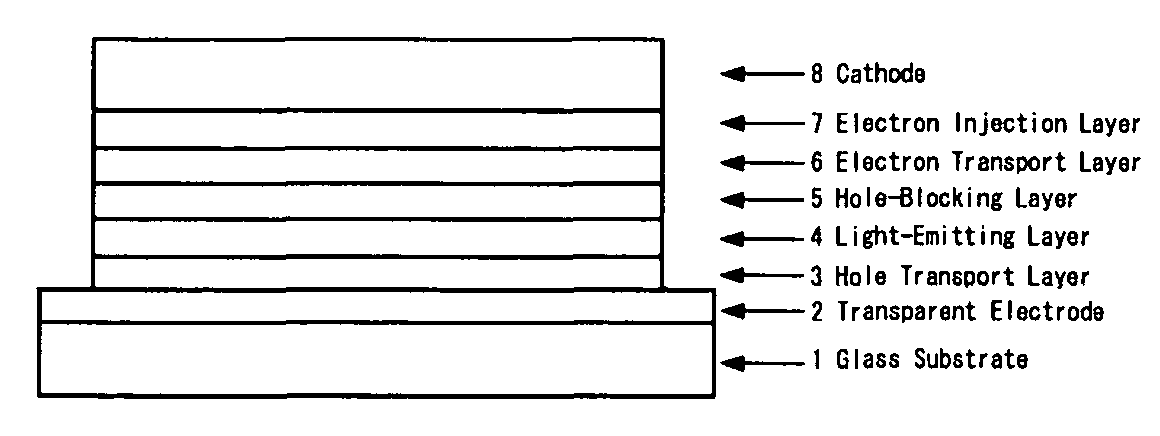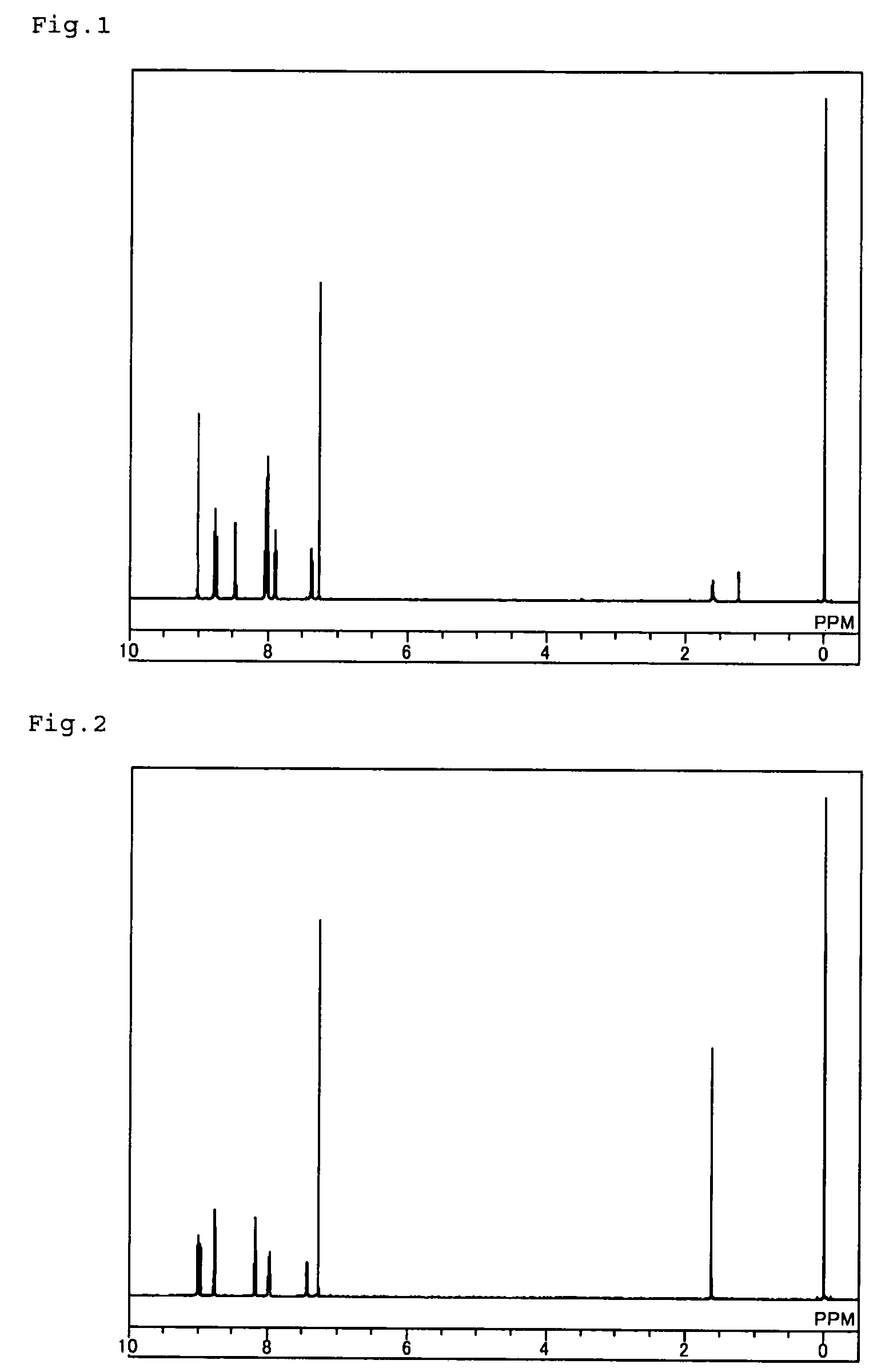Substituted bipyridyl compound and organic electroluminescent device
a technology of organic electroluminescent devices and bipyridyl compounds, which is applied in the direction of discharge tubes/lamp details, natural mineral layered products, anthracene dyes, etc., can solve the problems of low electron transportability, poor film stability, and efficiency reduction, and achieve excellent hole blocking ability, rapid electron transfer, and improved light luminous efficiency
- Summary
- Abstract
- Description
- Claims
- Application Information
AI Technical Summary
Benefits of technology
Problems solved by technology
Method used
Image
Examples
example 1
Synthesis of 1,3,5-tris(2,2-′bipyridin-6-yl)benzene (compound 6)
[0071]8.6 g of 1,3,5-tribromobenzene, 25.0 g of bis(pinacolato)diboron, 24.1 g of potassium acetate, 250 ml of dimethyl sulfoxide previously dewatered with Molecular Sieves 4A, and 1.4 g of PdCl2(dppf)-CH2Cl2 were put into a nitrogen-purged reactor, then heated, and stirred at 80° C. for 20 hours. After cooled to room temperature, the reaction liquid was put into 1000 ml of water, and stirred for 30 minutes. The precipitate was collected through filtration, and the precipitate was washed with methanol to obtain a crude product. The crude product was dissolved in 200 ml of ethyl acetate, the insoluble matter was removed through filtration, and the filtrated was concentrated to dryness to obtain 7.1 g (yield 57%) of a white powder, 1,3,5-tris(4,4,5,5-tetramethyl-[1,3,2]dioxabororan-2-yl)benzene.
[0072]2.5 g of the obtained 1,3,5-tris(4,4,5,5-tetramethyl-[1,3,2]dioxabororan-2-yl)benzene, 3.8 g of 6-bromo-[2,2′]-bipyridine, ...
example 2
Synthesis of 2,4,6-tris(2,2′-bipyridin-6-yl)-[1,3,5]triazine (compound 8)
[0075]5.0 g of [2,2′]-bipyridine-6-carbonitrile, and 0.2 g of sodium hydride were put into a nitrogen-purged reactor, then heated and stirred at 150° C. for 7 hours. After cooled to room temperature, 15 ml of methanol was added to the reaction liquid, and further stirred for 1 hour. Subsequently, this was processed for liquid-liquid separation with 70 ml of water and 100 ml of chloroform added thereto, and the organic layer was further washed with 50 ml of water. The organic layer was dewatered with anhydrous sodium carbonate and concentrated to obtain a crude product. The crude product was purified through recrystallization with 70 ml of orthodichlorobenzene to obtain 2.3 g (yield 46%) of a pale yellow powder, 2,4,6-tris(2,2′-bipyridin-6-yl)-[1,3,5]triazine (compound 8).
[0076]The structure of the obtained pale yellow powder was identified through NMR. The 1H-NMR data are shown in FIG. 2.
[0077]In the 1H-NMR (CD...
example 3
Synthesis of 1,2,4,5-tetrakis(2,2′-bipyridin-6-yl)benzene (compound 15)
[0078]Like in the above-mentioned Example 1, 1,2,4,5-tetrakis(4,4,5,5-tetramethyl-[1,3,2]dioxabororan-2-yl)benzene was produced from 1,2,4,5-tetrabromobenzene and bis(pinacolato)diboron. 2.1 g of the obtained 1,2,4,5-tetrakis(4,4,5,5-tetramethyl-[1,3,2]dioxabororan-2-yl)benzene, 4.1 g of 6-bromo-2,2′-bipyridine, 21.8 ml of aqueous 2 M potassium carbonate solution, 0.2 g of tetrakis(triphenylphosphine)palladium(0), 120 ml of toluene and 30 ml of ethanol were put into a nitrogen-purged reactor, and heated under reflux with stirring for hours. After cooled to room temperature, this was processed for liquid-liquid separation with 100 ml of water and 300 ml of chloroform added thereto, and the organic layer was further washed with 100 ml of water. The organic layer was dewatered with anhydrous magnesium sulfate and then concentrated to obtain a crude product. The crude product was purified through column chromatograph...
PUM
| Property | Measurement | Unit |
|---|---|---|
| work function | aaaaa | aaaaa |
| Tg | aaaaa | aaaaa |
| work function | aaaaa | aaaaa |
Abstract
Description
Claims
Application Information
 Login to View More
Login to View More - R&D
- Intellectual Property
- Life Sciences
- Materials
- Tech Scout
- Unparalleled Data Quality
- Higher Quality Content
- 60% Fewer Hallucinations
Browse by: Latest US Patents, China's latest patents, Technical Efficacy Thesaurus, Application Domain, Technology Topic, Popular Technical Reports.
© 2025 PatSnap. All rights reserved.Legal|Privacy policy|Modern Slavery Act Transparency Statement|Sitemap|About US| Contact US: help@patsnap.com



